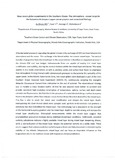
Antarctic Legacy Archive
New ocean glider experiments in the Southern Ocean: The atmosphere - ocean tango in the Subantarctic impacts upper ocean physics and associated biology
- ALSA Home
- →
- Documents
- →
- Research: Events, Presentations, Posters
- →
- View Item
JavaScript is disabled for your browser. Some features of this site may not work without it.
| dc.contributor.author | Du Plessis, M.D. | |
| dc.contributor.author | Swart, S. | |
| dc.contributor.author | Ansorge, I.J. | |
| dc.contributor.author | Mahadevan, A. | |
| dc.coverage.spatial | Southern Ocean | |
| dc.date.accessioned | 2021-03-10T14:46:59Z | |
| dc.date.available | 2021-03-10T14:46:59Z | |
| dc.date.created | 2016/07/27 | |
| dc.date.issued | 2016/07/27 | |
| dc.identifier.uri | http://hdl.handle.net/123456789/28599 | |
| dc.description.abstract | A fundamental process in regulating the global climate is the exchange of CO2 and heat between the atmosphere and the ocean. This exchange is facilitated within the oceanic mixed layer. The vertical transfer of properties from the mixed layer to the ocean interior is therefore an important process in the climate CO2 and heat budget. Submesoscale flows are capable of varying the mixed layer stratification and stability, altering the vertical motions within the mixed layer and below. This study applies in situ ocean observations as well as ancillary winds and surface heat fluxes to emphasize how atmospheric forcing interacts with submesoscale processes to characterise the variability of the upper ocean. In the Atlantic Subantarctic Zone, two ocean gliders were deployed as part of the third Southern Ocean Seasonal Cycle Experiment (SOSCEx III), continuously sampling the energetic Antarctic Circumpolar Current from mid-winter to the end of summer. The observational strategy was to monitor a single location (within 20 km) for one seasonal cycle (winter to summer) and provide persistent high-resolution information of temperature, salinity, surface and depth-mean currents and fluorescence. We find that in the presence of a wind directed along a surface buoyancy front in the direction of the flow induces a cross-frontal Ekman flow that destratifies the mixed layer. This flux is able to erode the mixed layer stratification and deepen the mixed layer depth. Interspersing the down-frontal winds were synoptic scale up-front wind reversals that promote a stabilising flux that restratified the mixed layer. This restratifying flux is dependent on the strength of the horizontal buoyancy gradient and the mixed layer depth to override mixing and increase the mixed layer stratification. Chlorophyll measurements within the mixed layer suggest that phytoplankton production increase during stabilised mixed layer conditions. Additionally, potential vorticity calculations indicate a highly unstable mixed layer during mixed layer deepening phases, while a restratification of the mixed layer returns the potential vorticity to a stable state. These results suggest that submesoscale horizontal buoyancy fronts are likely important in determining the stability of the Atlantic Subantarctic mixed layer and can have an important influence on the biogeochemistry in the Southern Ocean with impacts on climate predictions. | en_ZA |
| dc.description.sponsorship | Sponsored by the the Department of Science and Innovation(DSI) through National Research Foundation (NRF) - South Africa | en_ZA |
| dc.description.statementofresponsibility | Antarctic Legacy of South Africa | en_ZA |
| dc.format | en_ZA | |
| dc.language | English | en_ZA |
| dc.publisher | South African National Antarctic Programme (SANAP) | en_ZA |
| dc.relation | SANAP Symposium 2016 | en_ZA |
| dc.rights | Copyright | en_ZA |
| dc.subject | Research | en_ZA |
| dc.subject | Science | en_ZA |
| dc.subject | Meetings | en_ZA |
| dc.subject | Symposium | en_ZA |
| dc.subject | SANAP Symposium 2016 | en_ZA |
| dc.subject | Southern Ocean | en_ZA |
| dc.subject | Earth Systems | en_ZA |
| dc.subject | Marine Science | en_ZA |
| dc.subject | Ocean Science | en_ZA |
| dc.subject | Research | en_ZA |
| dc.subject | Oceanography | en_ZA |
| dc.subject | CO2 | en_ZA |
| dc.subject | Gliders | en_ZA |
| dc.subject | Climate Change | en_ZA |
| dc.title | New ocean glider experiments in the Southern Ocean: The atmosphere - ocean tango in the Subantarctic impacts upper ocean physics and associated biology | en_ZA |
| dc.type | Poster_Abstracts | en_ZA |
| dc.rights.holder | Antarctic Legacy of South Africa | en_ZA |
| dc.rights.holder | Du Plessis, M.D. | en_ZA |
| dc.rights.holder | Swart, S. | en_ZA |
| dc.rights.holder | Ansorge, I.J. | en_ZA |
| dc.rights.holder | Mahadevan, A. | en_ZA |
| iso19115.mdconstraints.uselimitation | This item and the content of this website are subject to copyright protection. Reproduction of the content, or any part of it, other than for research, academic or non-commercial use is prohibited without prior consent from the copyright holder. | en_ZA |
| iso19115.mddistributor.distributorcontact | South African National Antarctic Programme (SANAP) | en_ZA |
| iso19115.mdformat.name | en_ZA | |
| iso19115.mdidentification.deliverypoint | Antarctic Legacy of South Africa, Faculty of Science, Private Bag X1, Matieland. Stellenbosch. South Africa. | en_ZA |
| iso19115.mdidentification.electronicmailaddress | antarcticlegacy@sun.ac.za | en_ZA |
| iso19115.mdidentification.organizationname | University of Cape Town | en_ZA |
| iso19115.mdidentification.organizationname | Southern Ocean Carbon and Climate Observatory | en_ZA |
| iso19115.mdidentification.organizationname | Woods Hole Oceanographic Institution | en_ZA |
Files in this item
This item appears in the following Collection(s)
-
Research: Events, Presentations, Posters [480]
Material directly related to official scientific and research events



